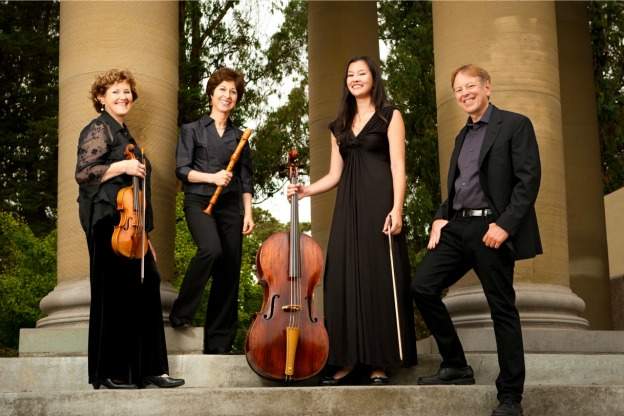
Time capsule for this episode: 1445
Note: The host for this episode is WFIU Public Radio announcer Annie Corrigan. Trivia: This is the first time in over 20 years anyone has ever sat in for Angela Mariani!
Music for the Harp
The harp is an instrument of ancient origin whose family members accumulated a wide array of labels and performed multiple roles. Of the many stained glass windows of Chartres Cathedral, one contains an image of King David holding what looks to be an upright harp with a gently curved frame. Images and accounts from different locales, such as a mosaic from the synagogue of Gaza, depict the mighty king playing upon what might better be called a lyre. Numerous other ambiguities reveal themselves as we look back on an instrument and its progress through time.
Jacob Senleches's La harpe de melodie, a rare and visually appealing piece from the 14th-century Codex Chantilly, is notated in the shape of a harp. La harpe de melodie provides rare performance instructions calling for a harp to play its slow-moving tenor line. Some believe that this might be achieved by repeatedly plucking the strings and allowing their sound to ring.
When the harp first made its appearance in 16th-century Spanish sources, it was strongly linked with keyboard instruments that often played the same repertoire and performed similar functions. The first known piece specified for harp comes from an unpublished volume of intabulations by Alonso Mudarra. Mudarra had intended the entirety of his work for organists and harpists. Players of either or both instruments could skilfully perform intricate glosses on prior composed music and approach more amorphous preludes with grace and nuance.
Musica Pacifica
Emerging from a collaborative group of soloists in the San Francisco Bay area, the ensemble Musica Pacifica has been wowing North-American audiences for over 20 years with their spirited approach to baroque music.
Founding member Judith Linsenberg recalls that after having such fun in collaboration, what was in 1990 called the Bay Area Baroque Soloists decided to send in a bona fide demo tape for consideration at the San Francisco Early Music Society. They won a spot in the organization's yearly concert series, and from there, took off.
At that same time, Judith secured an American Recorder Society grant to record her arrangements of Bach organ trios for recorder, violin, and continuo. This recording became "Musica Pacifica's first." These days, the ensemble boasts a sizeable discography including repertoire of Telemmann, Scarlatti, and others.
A number of Musica Pacifica's recordings seem to highlight a "meeting place" between folk and classical baroque music. Violinist Elizabeth Blumenstock, another original member, offers "I think that perhaps folk music and 'classical baroque' music met on dance floors throughout Europe. . . . dance music is arguably folk music, however elegant and clever it might become to please upper classes eager to distance themselves from the hoi polloi."
This knowledge helps inspire fresh and improvisatory approaches to well-known works by Antonio Vivaldi, and Francesco Mancini.
Dancing in the Isles
This recording highlights the musical cross-currents at play in Great Britain during the 17th and 18th centuries. Arrangements of English country dances, masques, and more attest to the richness of local traditions livened by exotic musical fashions from the European continent.
For example, during the 18th century when Scottish music was much in fashion, tunes either of genuine Scottish origin or written "in the Scottish style" were adopted into multi-movement solo sonatas and fitted to Italianate baroque basso continuo. James Oswald's Sonata of Scots Tunes in D Major is one example of this.
Elizabeth Blumenstock offers her opinion on what motivates this process of musical adaptation: "People are inveterate tinkerers . . . combining and recombining elements into new forms for their pleasure - look at dog and flower breeding, for example. This is all about cultural evolution through artificial selection, a direct analog to what nature does mindlessly."
When asked about their latest recording, Elizabeth and Judith both pointed out how the simplest traditional tunes can inspire creative and lively arrangements, as well as moods expressing sincere joy and sorrow. Instruments heard on Dancing in the Isles-a gutsy gamba, a droning violin, and a "folky" whistle-help coax out the spirit of each piece. They may even inspire listeners to get up and dance!
Click here to read our entire interview with Musica Pacifica's Judith Linsenberg and Elizabeth Blumenstock.
Featured release: Music from Jesuit missions in the Amazon
Our featured release this week takes us into the heart of the Amazon rainforest, bringing to life the intermingling of native and foreign music from centuries ago. Sphera AntiQua was formed by violinists Javier Illán and Pablo Gutiérrez. Although originating in Spain, the ensemble's endeavours extend far beyond the peninsula, carrying strands of Spanish musical legacy to London, Amsterdam, and beyond.
Sphera AntiQua's latest project explores baroque music from Jesuit missions in the Amazon. The recording premiers 17th- and 18th-century works found in the archives of Moxos and Chiquitos in Bolivia. Musicians taking part in the project use jerures, chononos, and other indigenous wind and percussion instruments-such as a güiro crafted from a toucan's beak!









